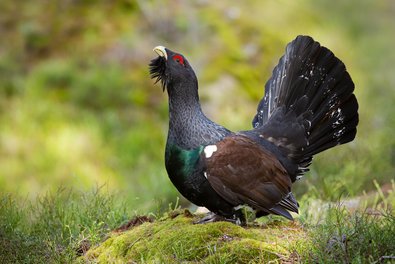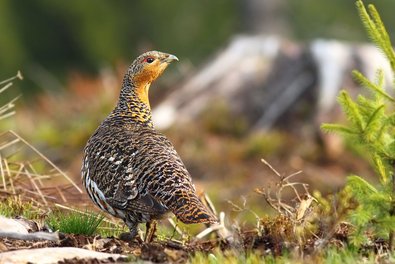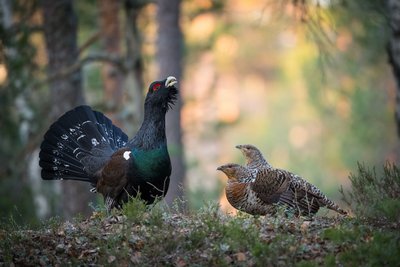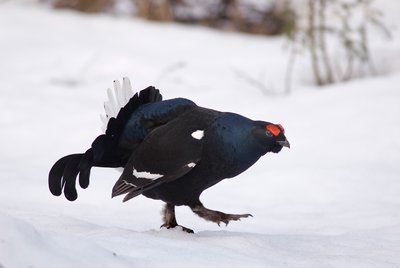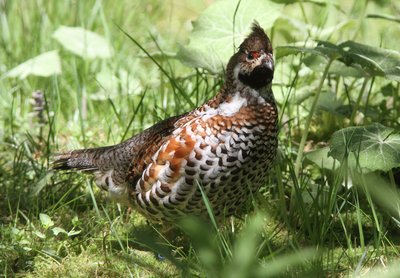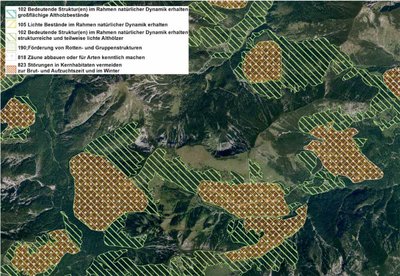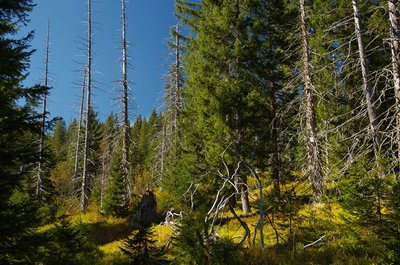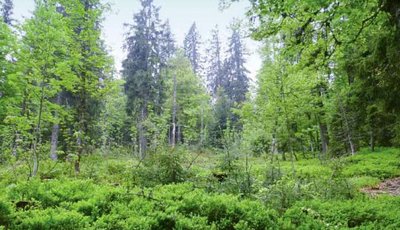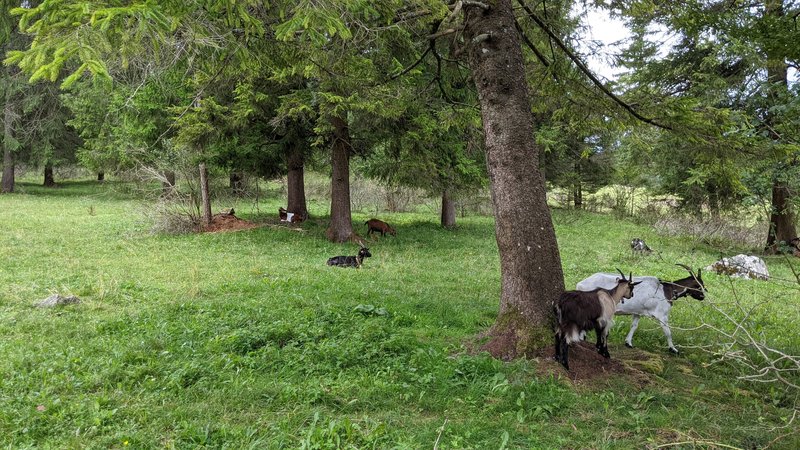Grouse, and particularly the wood grouse, also known as the capercaillie (Tetrao urogallus), are among the best-studied animal species. Protection measures focusing on this species group are however repeatedly the subject of considerable debate. One reason for this may be that in the last few decades, the responsibility for the central European deciduous forests, and especially the beech habitat types with their characteristic species, has quite rightly become the focus of conservation efforts. The protection of the grouse, which is really a bird of boreo-montane coniferous forests, has possibly thus lost some of its appeal, especially as it is often associated with devastating forms of forest use that are far from “close-to-nature”. The fact is, however, that there are natural grouse habitats available across significant areas in Bavaria. Forestry management must take measures to conserve these “natural” habitats, but also valuable man-made habitats, in order to maintain the diversity in our landscape.
Figs. 1 and 2: Male and female capercaillie. The capercaillie is an umbrella species for extensive, sparse and structurally rich mixed coniferous forests. (Pictures: PantherMedia / PetrSimon (l) / PantherMedia / taviphoto (r)).
Range and population in Bavaria
With the exception of the small black grouse population in the Rhön mountains, now helped by reintroduction, and sporadic sightings in Mittelfranken and Unterfranken, the documented occurrence of grouse in Bavaria is now restricted to the mid-range mountains of eastern Bavaria and the alpine region (see Table 1). This means that the populations still documented in the lowlands and hills in the 1970s have all but disappeared within 40 years. The loss of extensive pasture landscapes since the 1960s, the abandonment of forms of utilisation that resulted in degradation of the soil in particular, the promotion of endemic deciduous trees, and above all the high levels of nitrogen input into the soil, are all factors likely to have played a central role here. Under the sparse crowns of the once over-used, slow-growth pine forests of the Franken and Oberpfalz regions, there is now a well-establishe, waist-high, dense layer of herbaceous vegetation.
In the Alps and mid-range hills of Bavaria, on the other hand, more extensive habitats are still available. The natural “isolation” of the habitats due to altitude zones and the topography of the terrain mean that the habitats there must be also be dealt with sensitively.
Habitats in the Alps
In order to show the potential natural habitat of grouse in the Bavarian alpine region (Growth area 15) over a large area for the first time, we evaluated the forest types of the WINALP forest information system for the northern Alps. For the capercaillie, for example, sites were selected that are potentially home to natural high-altitude spruce forests, fir forests rich in berry shrubs, larch and stone pine forests, or the generally more coniferous-dominated uppermost swathes of mixed mountain forests. Likewise, particularly valuable azonal habitats such as moorland forests, winter heath-pine forests or coniferous scree forests in cold air streams were taken into account. This scenery represents the potential natural habitat of the capercaillie in the Bavarian alpine region, and comprises some 81.000 ha (see Fig. 3 and Table 1). In comparison with approx. 125.000 ha of black grouse habitat, not to mention the 355.000 ha of hazel grouse habitat, the natural habitat of the capercaillie is relatively small.
This becomes clear as soon as we consider the potential natural proportion of the area of forest societies with spruce as the main tree species: in Bavaria this is estimated to be approx. 5 % of the forest area. Additionally, the habitats of the birds have changed considerably over the centuries. Around 40 % of the potential capercaillie habitats in the alpine region are for example no longer covered with forest at all. These aspects must be taken into consideration in the subsequent planning of conservation measures.
Habitat requirements of the birds
The capercaillie is considered to be a flagship species of boreo-montane forests. As a taiga forest dweller, it is adapted to rather sparse areas of expansive and thus seldom disturbed areas of mixed coniferous forest with low growth. Because of its diverse habitat requirements, sensitivity to disturbance and large spatial requirements, it is also considered an “umbrella species” for the species community of boreo-montane forests. This species community includes the Eurasian three-toed woodpecker, the ring ouzel (Turdus torquatus), the citril finch (Carduelis citrinella), the Eurasian pygmy owl (Glaucidium passerinum) and the boreal or Tengmalm’s owl (Aegolius funereus).
The black grouse has similar requirements, although unlike the capercaillie, it additionally requires very open areas for its courtship ritual. Boreal forest landscapes with large moors or lakes, which when frozen offer open areas ideal as a courtship arena, are thus home to both the capercaillie and the black grouse. The hazel grouse, on the other hand, avoids open and thus cover-free areas, and is a typical inner forest dweller.
All species require a loose, easily penetrable herbaceous layer - preferably in the form of berry shrubs such as blueberry (Vaccinium myrtillus), lingonberry (Vaccinium vitis-idaea) or bog bilberry (Vaccinium uliginosum). They avoid dense and dark forests. High proportions of pioneer tree species such as birch, willow or alder are very important, as they provide structure, and their buds are a source of food. This strong attachment to certain structures makes the birds good indicator species. In the discussion about umbrella species, it should however be considered that all three “forest grouse” can also colonise replacement habitats created by humans. This is most obvious in the case of the capercaillie: it also inhabits sparse spruce forests in mountainous mixed forest areas short of trees in ageing and decaying phases, for example. So the birds are not necessarily always indicators of the forest being “close to nature”.
To set conservation objectives in forests, it is thus necessary to have an overview of the habitat requirements of the respective flagship and keystone species characteristic of the areas in question. It can thus never be the objective of forest conservation efforts to create an ideal forest for capercaillie or black grouse across the entire area.
Avoiding conflicting goals and setting priorities
For grouse protection to be successful and to make sense from a conservation point of view, there must be a clear formulation of objectives and setting of priorities. Only then can conservation concerns be integrated into land use and potential conflicts of objective prevented. An overview of the site (climate, soil, exposition), potential natural and actual vegetation cover, and the structures it offers (e.g. proportions of deadwood and habitat trees, gaps in the cover, succession areas, a diverse herbaceous layer with short-growing grasses) is decisive for the assessment of the “conservation value” of an area.
We thus suggest the following prioritisation:
- Natural habitats should be protected and maintained. Site-adapted natural habitats with their characteristic species communities should be preserved.
- Replacement habitats with healthy grouse populations should be preserved in the cultivated landscape. In areas in which a particular management practice has led to the creation of valuable grouse habitats with reproducing populations, the existing management practice should be continued.
- Replacement habitats with very low numbers of grouse: Protective measures should only be continued in these areas if they do not conflict with other conservation objectives.
Experiences from the Natura 2000 bird protection areas
Experiences from Natura 2000 management planning in the Bavarian Special Protection Areas show ways of successfully implementing forest conservation measures. Since 2006, management plans have been drawn up for around 550.000 ha in 84 bird protection areas (Special Protection Areas = SPA). The objects of protection, an average of 20 bird species per SPA, are defined in the Natura 2000 ordinance for all areas. By naming these, the regionally characteristic species and their habitats are defined, thus establishing an initial prioritisation of nature conservation goals.
For the capercaillie, for example, the priority areas outlined in the Alps make up an average of 12 % of the total area. In terms of site potential and forest structure, they are expected to offer favourable habitat conditions for the capercaillie even in the long term. These priority areas are also embedded in an additional set of measures, which are usually also important for other objects of protection.
Favourable conservation status: The objective of Natura 2000 area management plans is to maintain or restore the favourable conservation status of the respective objects of protection. The primary objective is thus to maintain the populations and their habitats in the respective area. To determine the conservation status of a species, not only the “population status” is evaluated, but also the “habitat quality” and possible “threats”. The assessment thresholds are specified in the surveying guidance for the species. How the respective conservation status of the species in the area is arrived at is thus made transparent for the advisory authorities and land owners.
Grouse-friendly silviculture
The Natura 2000 inventories in the alpine SPAs have shown that there is not a fundamental lack of sparse, older, coniferous-dominated forest stands. The condition of the herbaceous layer is however problematic. The proportion of berry shrub cover is naturally low in the northern limestone Alps, at just 5 to 6 % of the area. Due to the still high levels of deposition of atmospheric nitrogen, a changing climate, and higher proportions of deciduous trees in future, we can expect in many places in mountain regions to see a significant change in the humus types and thus of ground vegetation, to the detriment of berry shrubs. A herbaceous layer that is too thick and increasing grass cover is particularly unfavourable for the development of the young birds.
The central problem of grouse-friendly forest management in Bavaria is thus not a lack of sparse forests, but the preservation of sparse forests with a loose and thus easily penetrable herbaceous layer, especially for young birds. One possible strategy would be to regenerate extensive areas of forest rich in old trees in small patches and over long periods of time. Similarly, forest structures created by the alternation of small areas of dense and sparse phases in the size of small patches and groups are also likely to be successful. They imitate the natural group structures in high-altitude spruce forests, which are usually due to regeneration on deadwood (nurse log regeneration). In the dense tree patches there is not enough light for the development of ground vegetation, whereas at the edges of these groups, a lot of light reaches the ground, and a transitional area is created in the parts with a more sparse canopy.
Even in parts of younger stands, selective cutting in the form of holes or corridors or a group thinning can create valuable structures for the grouse. The corridors created for winch cables or skid trails designed to minimise impact on the soil during harvesting measures can also be beneficial in terms of creating sparse forest structures. Clear-cuts or cuts in transitional areas, on the other hand, only create habitable habitats temporarily for the animals. These should be avoided on a larger scale.
In times of climate change, we can expect an increase in the number and severity of disturbance events such as windthrow or bark beetle calamities. Experience from the Bavarian Forest shows however that even large clear areas continue to be colonised by the grouse if larger-diameter deadwood is left in the stand and interspersed with regeneration.

Fig. 10: The removal of groups of trees, e.g. by hole cutting, promotes the group structures in commercially managed forests. This creates forest edges and gaps (shaded green) that are favourable for the capercaillie. Structures of natural capercaillie habitats in high-altitude coniferous forests (b) or the uppermost layers of mixed mountain forests (c) can be imitated well in this way. (Source: adapted from Schröder, W., et. al).
Pasture grazing
For the black grouse, and also for the capercaillie, forest structures with short grass and gaps can be created through extensive pasture grazing. An extensive form of pasture grazing which does not completely prevent the emergence of secondary and pioneer tree species typical of the habitat, especially the deciduous trees that are vulnerable to grazing, can be very beneficial for grouse. Too intensive grazing or cutting back concepts or even the demand for high game populations do however cause problems. These things endanger the natural regeneration dynamics and thus the characteristic diversity of species in the protected habitat types. Especially tree species like the sycamore, deciduous wood pioneers or the fir are pillars of diversity in the mountain forest and also play an important role as a source of food for grouse. They urgently need to be preserved and promoted.

